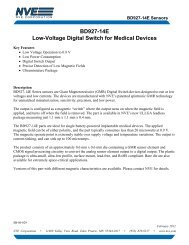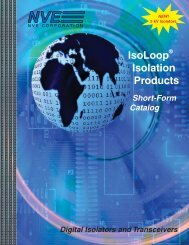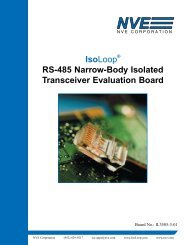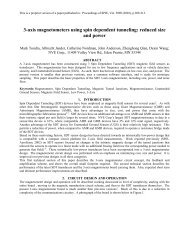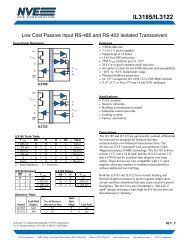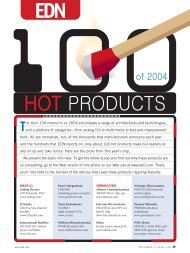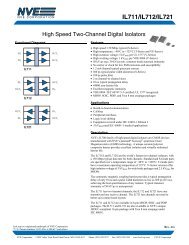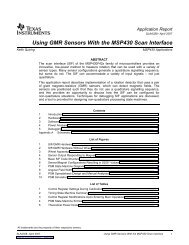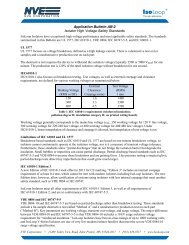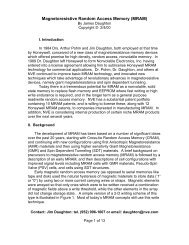very dense magnetic sensor arrays for precision ... - NVE Corporation
very dense magnetic sensor arrays for precision ... - NVE Corporation
very dense magnetic sensor arrays for precision ... - NVE Corporation
Create successful ePaper yourself
Turn your PDF publications into a flip-book with our unique Google optimized e-Paper software.
In one demonstration system small <strong>magnetic</strong> beads,coated with a material that binds to the biological moleculesto be analyzed are allowed to settle on a substrate that isselectively coated in different areas with substances thatbond to specific molecules of interest. After removing thebeads that are not bonded to the substrate via a molecule ofinterest, the presence of the remaining <strong>magnetic</strong> microbeadsis detected by <strong>magnetic</strong> <strong>sensor</strong>s in the array. 16 17 Severalbioassays can be simultaneously accomplished using anarray of <strong>magnetic</strong> <strong>sensor</strong>s, each with a substance that bondsto a different biological molecule. This application requiresextremely small, low-power, low-field <strong>magnetic</strong> <strong>sensor</strong>s.Several groups have experimented with usingcommercially available GMR <strong>sensor</strong>s to detect coated<strong>magnetic</strong> beads as bio<strong>sensor</strong>s. However, the per<strong>for</strong>manceof packaged <strong>sensor</strong>s of any type is limited by the plasticencapsulation used to protect the underlying <strong>sensor</strong> chip.The 8-pin SOIC package used by <strong>NVE</strong> <strong>for</strong> commercialGMR <strong>sensor</strong>s has a spacing between the GMR element andthe top of the package of 0.5 mm and an even greaterdistance from the element to the end of the package.Magnetic microbeads when magnetized by an external fieldhave a <strong>magnetic</strong> dipole field. The rapid decrease in fieldwith distance requires that the sensitive area be of similarsize to the microbeads. If the sensitive area is much largerthan the bead, only the portion of the magnetoresistivematerial close to the bead will be affected. There<strong>for</strong>e thefractional change in resistance, and hence the sensitivity,will be maximized by matching the size of the <strong>sensor</strong> to thesize of the bead. This requirement matches the attributes ofSDT <strong>sensor</strong>s.In a proof of concept experiment an array of 80 x 5µm GMR <strong>sensor</strong> elements was fabricated from sandwichGMR material. 18 Each <strong>sensor</strong> was coated with differentbiological molecules that will bond to different materials tobe assayed. The <strong>magnetic</strong> microbeads were coated with thematerials to be analyzed. The microbeads in suspensionwere allowed to settle onto the GMR <strong>sensor</strong> array wherespecific beads bonded to specific <strong>sensor</strong>s only if thematerials were designed to attract each other. Non-bindingbeads were removed by a small <strong>magnetic</strong> field. The beadswere then magnetized at 200 Hz by an ac electromagnet.The 1 µm microbeads were made up of nm sized iron oxideparticles that have little or no magnetization in the absenceof an applied field. A lock-in amplifier extracted the signalthat occurred at twice the exciting frequency from aWheatstone bridge constructed of two GMR <strong>sensor</strong>elements, one of which was used as a reference and twonormal resistors. High-pass filters were used to eliminateoffset and the necessity of balancing the two GMR <strong>sensor</strong>elements. With this detection system, the presence of asfew as one microbead could be detected. The miniaturenature of GMR <strong>sensor</strong> elements allows an array tosimultaneously test <strong>for</strong> multiple biological molecules ofinterest.An integrated GMR <strong>sensor</strong> can include the array of<strong>sensor</strong>s, the processing electronics, the current straps thatprovide the field to magnetize the microbeads, and even thefluid handling microchannels on the same substrate. Figure18 shows a cross section of such a <strong>sensor</strong>. Systems basedon this technology can be developed to automaticallyanalyze biological materials in the field without extensivelaboratory equipment.M1Metal 11.5 µm AlSilicon NitrideChannelBCB5 µm thickBuried Metal (M0) 1.5 µm AlPDMS LidFluidChannelMagneticBeadwindow nitride 200 nmGiant Magnetoresistive (GMR) Filmswindow nitride~ 500 nm Chemical-Mechanical Polished (CMP) Surface [or BCB + thin nitride]Silicon Nitride 200 nmSilicon SubstrateSilicon NitrideChannelBCB5 µm thickSputtered Silicon NitrideContactwell andbondingpadMetal 11.5 µm AlAlN etch stopFigure 18. The state of the art at <strong>NVE</strong> <strong>for</strong> <strong>magnetic</strong> devicescombined with microfluidics.Figure 19 shows a bio<strong>magnetic</strong> IC experimentalarray, without fluidic channels developed by <strong>NVE</strong> <strong>for</strong> testby biotechnology companies.Figure 19. <strong>NVE</strong>’s first bio<strong>sensor</strong> array including the board.It consists of three different sized resistor bridges andthree different sized discrete resistor <strong>arrays</strong>. Thesedevices will be sampled to biotechnology firms in 2003.9



